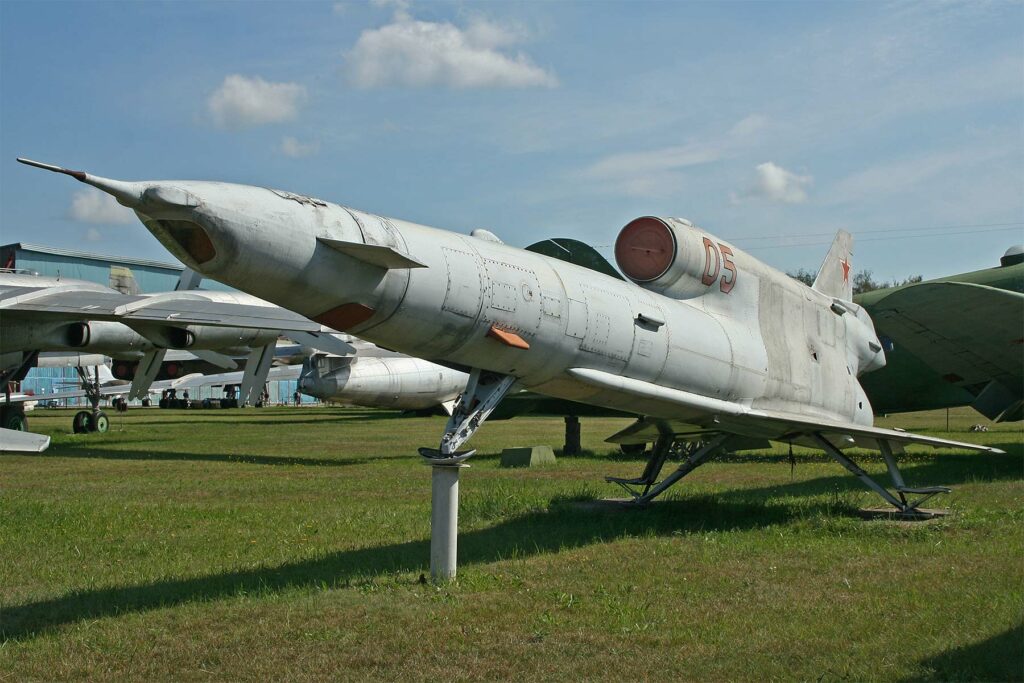Soviet-era high-speed, medium-range reconnaissance drone with a turbojet engine.
In brief
The Tupolev TU-141 Strizh is an unmanned aerial vehicle designed for reconnaissance missions. Equipped with a Tumansky KR-17A turbojet engine providing 4,409 lbf of thrust, it achieves a maximum speed of 683 mph and a range of 621 miles. With a service ceiling of 19,700 feet, the TU-141 operates effectively in diverse reconnaissance roles, featuring robust capabilities for high-speed, medium-range tasks.
History of the Development of the Tupolev TU-141 (Strizh)
The Tupolev TU-141 Strizh was developed during the latter half of the Cold War to meet the Soviet Union’s need for a reliable and efficient reconnaissance drone. Originating from the experience gained with the earlier TU-123, the TU-141 was designed to provide enhanced performance and flexibility. The development of the TU-141 began in the early 1970s, with its first flight recorded in 1974. Officially entering service in 1979, it was produced until 1989, designed to execute deep penetration reconnaissance missions over enemy territory. The TU-141 was built to replace older models and respond to the evolving technological landscape of aerial reconnaissance.
Design of the Tupolev TU-141 (Strizh)
The TU-141 Strizh showcases a streamlined, missile-like fuselage designed for high-speed flight. It features a clipped delta wing configuration with canards to improve lift and maneuverability. The airframe integrates a turbojet engine mounted atop the fuselage, facilitating a high thrust-to-weight ratio essential for rapid acceleration and sustained high-speed flight. The UAV employs a launch rail system for deployment and utilizes a parachute for recovery, highlighting its design focus on operational efficiency and safety in hostile environments.

Performance of the Tupolev TU-141 (Strizh)
The TU-141 Strizh is powered by a single Tumansky KR-17A turbojet, enabling a top speed of approximately 683 mph and a cruising speed close to 621 mph. It has a maximum operational range of 621 miles and can ascend to altitudes up to 19,700 feet. This performance profile allows the TU-141 to conduct extensive reconnaissance missions over considerable distances, providing valuable intelligence while operating at speeds that reduce the likelihood of enemy interception.
Variants of the Tupolev TU-141 (Strizh)
The TU-141 Strizh itself serves as the base model for this series of UAVs. Its design principles and technical specifications underpin several derivative models, but the TU-141 remains distinct for its specific configuration tailored to high-speed, medium-range reconnaissance missions.
Military Use and Combat of the Tupolev TU-141 (Strizh)
The TU-141 was extensively used by the Soviet military throughout the late Cold War period for reconnaissance missions. Its capability to gather intelligence at high speeds and from significant distances made it a valuable asset in monitoring NATO forces and other potential adversaries. Following its retirement in the early 1990s, the TU-141 was briefly resurrected by Ukraine in 2014 for use in the conflict in Eastern Ukraine, demonstrating the UAV’s enduring utility in modern military operations.
The Tupolev TU-141 Strizh represents a significant advancement in the field of unmanned aerial reconnaissance. Its development and operational history reflect the strategic priorities of the Soviet Union during the Cold War and its legacy continues to influence UAV design and deployment strategies today. With ongoing conflicts and the evolution of surveillance technology, the foundational design and capabilities of the TU-141 continue to be relevant in contemporary military strategy.
Back to the Drones, UAVs, UCAVs page